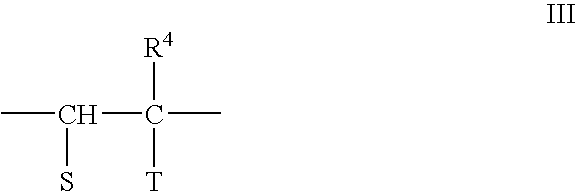Fast drying gypsum products
a technology of gypsum and fast drying, which is applied in the field of fast drying gypsum products, can solve the problems of occupying a large space to stack and store wallboard, affecting the quality of gypsum products, so as to reduce the cost of gypsum wallboard panels, reduce drying costs, and reduce water levels
- Summary
- Abstract
- Description
- Claims
- Application Information
AI Technical Summary
Benefits of technology
Problems solved by technology
Method used
Image
Examples
example 2
[0048] The same procedures used for Example 1 above were used to test three dispersants of this invention. Results, including those for the MELFLUX 2500L dispersant, are shown in Table II.
TABLE IISamplePattyVicat SetNo.DispersantCSAWSRSizeTimeMELFLUX 2641F50.10%0.6g0.5417.75:0560.20%1.5g0.4616.514:4570.30%3.75g0.4314.64:40MELFLUX 2651F8 0.1%0.6g 0.54.16.435:309 0.2%1.5g. 0.46.20.344:5010 0.3%3.75 0.43.21.35:40MELFLUX 2500L11 0.100.6g0.5419.24:5012 0.201.5g 0.46.19.64:5013 0.303.750.4319.74:20
[0049] As shown above, the 2641 and 2651 dispersants are as good as, or better than, the base MELFLUX 2500L dispersant and better than the MELFLUX 1641F dispersant of the comparative example in its ability to make a highly fluid mixture without significantly increasing the set times.
example 3
[0050] Table III below shows the formulations of gypsum wallboard panels formulated with and without the three repeating unit dispersant of the present invention. Formulations for ½″ boards with and without the dispersant are shown. Unless otherwise noted, the amounts of the components are listed in pounds per 1000 square feet of board product (“MSF”). Metric equivalents in grams per square meter are reported in parenthesis beside the English units.
TABLE IIIComponent½″ Board½″ BoardStucco1180(5761)1144(5586)Gauging Water848(4140)738(3603)WSR0.810.75Total Water952(4648)853(4165)Soap0.28(1.37)0.29(1.42)Ground Gypsum16(78)17(83)AcceleratorStarch5(24.4)5(24.4)USG951(4.9)1(4.9)Naphthalene Sulfonate0(0)0MELFLUX 2500L01.1(5.4)PolycarboxylatePaper Fiber5(24.4)5(24.4)Glass Fiber00Trimetaphosphate0.6(2.9)0.6(2.9)
[0051] As can be seen in the above formulations, use of a three-repeating unit system allows wallboard to be formulated with reduced water demand, thus reducing energy costs for dry...
example 4
[0052] The effect of polycarboxylates varies with the particular stucco with which it is used. Table IV shows the reaction of gypsum slurries from a variety of gypsum sources to the polycarboxylate of this invention. MELFLUX 2500L was used with various gypsums to determine the WSR needed to make a slurry of a given flowability as measured by the patty test.
[0053] For each test, 400 grams of stucco were mixed with CSA and MELFLUX 2500L dispersant. Sufficient water was added to make a patty 20 cm in diameter. After addition, a timer was started and the water and dry components were allowed to soak for 15 seconds in a laboratory blender, then mixed for 15 seconds. A 2″×4″ slump cylinder in the automated tester was filled with the sample, along with a wax lined cup for Vicat set determination.
[0054] The top of the cylinder was screeded to level it and the cylinder was lifted to allow the slurry to flow freely on a smooth surface. When the patty stopped flowing, the diameter was measur...
PUM
| Property | Measurement | Unit |
|---|---|---|
| Fraction | aaaaa | aaaaa |
| Fraction | aaaaa | aaaaa |
| Percent by mass | aaaaa | aaaaa |
Abstract
Description
Claims
Application Information
 Login to View More
Login to View More - R&D
- Intellectual Property
- Life Sciences
- Materials
- Tech Scout
- Unparalleled Data Quality
- Higher Quality Content
- 60% Fewer Hallucinations
Browse by: Latest US Patents, China's latest patents, Technical Efficacy Thesaurus, Application Domain, Technology Topic, Popular Technical Reports.
© 2025 PatSnap. All rights reserved.Legal|Privacy policy|Modern Slavery Act Transparency Statement|Sitemap|About US| Contact US: help@patsnap.com



